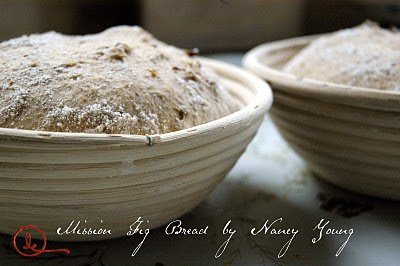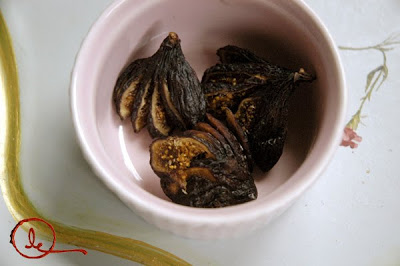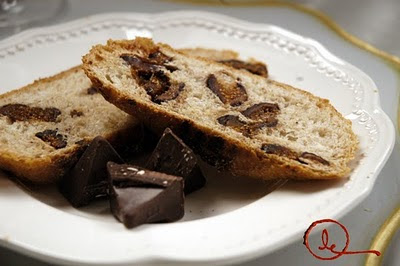Mission Fig Bread
By Nancy Young
 This isn't an inexpensive bread to make (it's around $1.50-2.00 per loaf) unless you are the proud possessor of your own fig trees: however, making it at home is much less costly than buying it at some chic, intimate Parisian bakery, and that's even before you've paid for the flight to France. We like it with pears, or cream cheese, or any cheese, or very dark chocolate.
This isn't an inexpensive bread to make (it's around $1.50-2.00 per loaf) unless you are the proud possessor of your own fig trees: however, making it at home is much less costly than buying it at some chic, intimate Parisian bakery, and that's even before you've paid for the flight to France. We like it with pears, or cream cheese, or any cheese, or very dark chocolate.
Mission Fig Bread by Nancy Young
Ingredients:
3 cups warm water (105-115 degrees)
1 tablespoon dried yeast
3 tablespoons olive oil
1 tablespoon salt
2 ½ cups whole wheat flour
3 or more cups white flour
About 10 ounces black mission figs, stems removed and sliced
Topping (optional)
1-2 tablespoons Extra Virgin Olive Oil
Salt

Pour the warm water into the bowl of a heavy-duty mixer, sprinkle in the yeast, and allow it to proof for about for five minutes or so. When yeast is creamy, add the olive oil, salt, whole wheat flour, and 3 cups of the white flour. Place bowl in stand and add the paddle attachment. Beat ingredients for about 3 minutes, then check the dough consistency. If the dough seems too wet, add more white flour ¼-½ cup of flour at a time until dough is still moist but not slack.
(Although for recipes I publish in the Storybook Home Journal I usually recommend switching to the dough hook at this point, for years now, I've used the paddle attachment exclusively for bread making. I stick to the tried-and-true-for-everyone-else-method in the journal because I don't have space there to explain why I prefer the paddle to the dough hook, and I'm not sure it would suit everyone. But here, I can point out that, for me at least, the paddle creates a lighter, more elastic dough with less stress on the mixer—mine's a Kitchenaid, by the way.) So, having said that, using the paddle attachment (or the dough hook, if you prefer) continue beating (or kneading) until the top of the mixer starts to feel warm. At this point the dough should have coalesced and be rather stretchy. Add the figs and beat just long enough for the figs to be incorporated, but not long enough for them to break down. Leave dough in the bowl and allow to rise until doubled—about an hour. Deflate dough, turn out onto your favorite dough-shaping surface—mine's granite—sprinkle the surface with a little flour, and shape into two or three rounds. These can rise in bannetons, as pictured, though they'll do just fine as freestanding loaves on a parchment-covered baking sheet. (If you want particularly gorgeous loaves, shape and bake them individually, 30 minutes apart.)
Preheat oven to 425 degrees. When loaves have fully doubled, invert from bannetons, if using, onto parchment-covered baking sheets. Lightly oil and salt the tops, if desired, though salty-sweet isn't to everyone's taste, and can be easily skipped. Place loaves in oven and immediately reduce heat to 400 degrees.
Bake until very golden, about 30 minutes or more. Cool on wire racks before slicing. (My mother and other very well behaved Europeans will tell you not to slice them until they've cooled for an hour. Because of that I can't tell you that this bread is particularly fun while the figs are still a little warm.)

Tags: 2010, Recipes by Nancy Young
Browse articles by year: 2025 . 2024 . 2023 . 2022 . 2021 . 2020 . 2019 . 2018 . 2017 . 2016 . 2015 . 2014 . 2013 . 2012 . 2011 . 2010 . 2009 . 2008 . 2007 . 2006 . 2005 . 2004 . 2003 . 2002 . 2001 . 2000 . 1999 . 1998 . 1997 . 1996
Browse articles by topic: Art lessons . BenHaven Archives . Blank art diaries . Fine art photography . Framing . Illustration . Inspiration and creativity . Isles of Rune . Limited Editions Collection . My Fathers Captivity . News . Novellas . Oil paintings and prints . Operations announcements . Orders and shipping . Overview . Portfolios . The Papers of Seymore Wainscott . Project commentaries . Recipes by Nancy Young . Recommended reading . Recommended viewing . Temple artworks . The Storybook Home Journal . Tips and techniques . Tools supplies and operations
Browse articles by topic: Art lessons . BenHaven Archives . Blank art diaries . Fine art photography . Framing . Illustration . Inspiration and creativity . Isles of Rune . Limited Editions Collection . My Fathers Captivity . News . Novellas . Oil paintings and prints . Operations announcements . Orders and shipping . Overview . Portfolios . The Papers of Seymore Wainscott . Project commentaries . Recipes by Nancy Young . Recommended reading . Recommended viewing . Temple artworks . The Storybook Home Journal . Tips and techniques . Tools supplies and operations